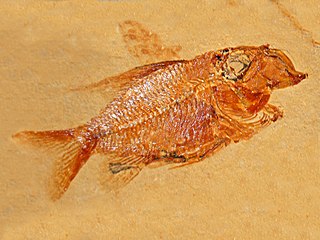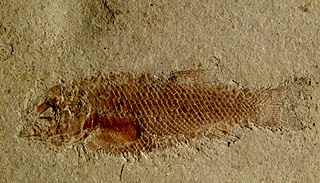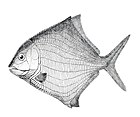Eosynanceja is an extinct genus of prehistoric ray-finned fish that lived during the lower Eocene.

Lissoberyx is an extinct genus of prehistoric ray-finned fish belongon to the family Trachichthyidae. Lissoberyx is a trachichthyid, but it shows more resemblance to the holocentrids than any other trachichthyid.

Eubiodectes is an extinct genus of prehistoric bony fish that lived during the Cenomanian.
Mesoclupea showchangensis is an extinct ichthyodectiform ray-finned fish that lived in freshwater environments in what is now China during the Early Cretaceous epoch. It differs from its sister genus, Chuhsiungichthys, primarily by having a more posteriorly-placed dorsal fin.
Arctosomus is an extinct genus of prehistoric bony fish that lived during the Early Triassic epoch.

Garnbergia is an extinct genus of prehistoric bony fish that lived during the Anisian stage of the Middle Triassic epoch.
Pseudoegertonia is an extinct genus of prehistoric bony fish that lived during the Maastrichtian age of the Cretaceous period and Danian age of the Paleocene epoch.

Eolactoria sorbinii is an extinct prehistoric boxfish that lived during the Lutetian epoch of the middle Eocene, in Monte Bolca. It had two pairs of long spines, one over each eye, and one pair beneath the anal and caudal fins, arranged very similarly to those possessed by the modern genus Lactoria, but were, in comparison, much longer. E. sorbinii had a fifth spine between the two eye-spines, arranged and looking very much like a nose.

Acentrophorus is an extinct genus of prehistoric ray-finned fish from the Wuchiapingian of England and Germany (Kupferschiefer). There may also be a Triassic occurrence in Australia.
Sundayichthys is an extinct genus of prehistoric bony fish that lived during the Carboniferous period in what is now South Africa. Fossils were recovered from the Upper Witteberg Series.

Eoeugnathus is an extinct genus of prehistoric ray-finned fish belonging to the Halecomorphi. Eoeugnathus existed during the Middle Triassic in what is now Italy, Spain, and Switzerland. The type species is Eoeugnathus megalepis (monotypy).
Egertonia is an extinct genus of prehistoric bony fish. The earliest occurrences of the genus in the fossil record are from the Late Cretaceous of Madagascar and India.

Notelops is an extinct genus of prehistoric ray-finned fish.

Phanerosteon is an extinct genus of prehistoric bony fish from the Carboniferous period. The type species, P. mirabile, was recovered from the Calciferous sandstone series (Pennsylvanian), Scotland. A second species, P. phonax was described from the Serpukhovian aged Bear Gulch Limestone lagerstätte in Montana, United States.
Pholidolepis is an extinct genus of prehistoric ray-finned fish.
Pholidophoroides is an extinct genus of prehistoric ray-finned fish.
Pleuropholis is an extinct genus of prehistoric ray-finned fish.

Thoracopteridae is an extinct family of prehistoric bony fish; classified with the order Peltopleuriformes. This lineage of Triassic flying fish-like Perleidiformes converted their pectoral and pelvic fins into broad wings very similar to those of their modern counterparts. However, this group is not related to modern flying fish from the family Exocoetidae, instead being a case of convergent evolution.

Spinacanthidae is an extinct prehistoric family of tetraodontid bony fish that lived from the Lutetian epoch of Eocene Monte Bolca.



















